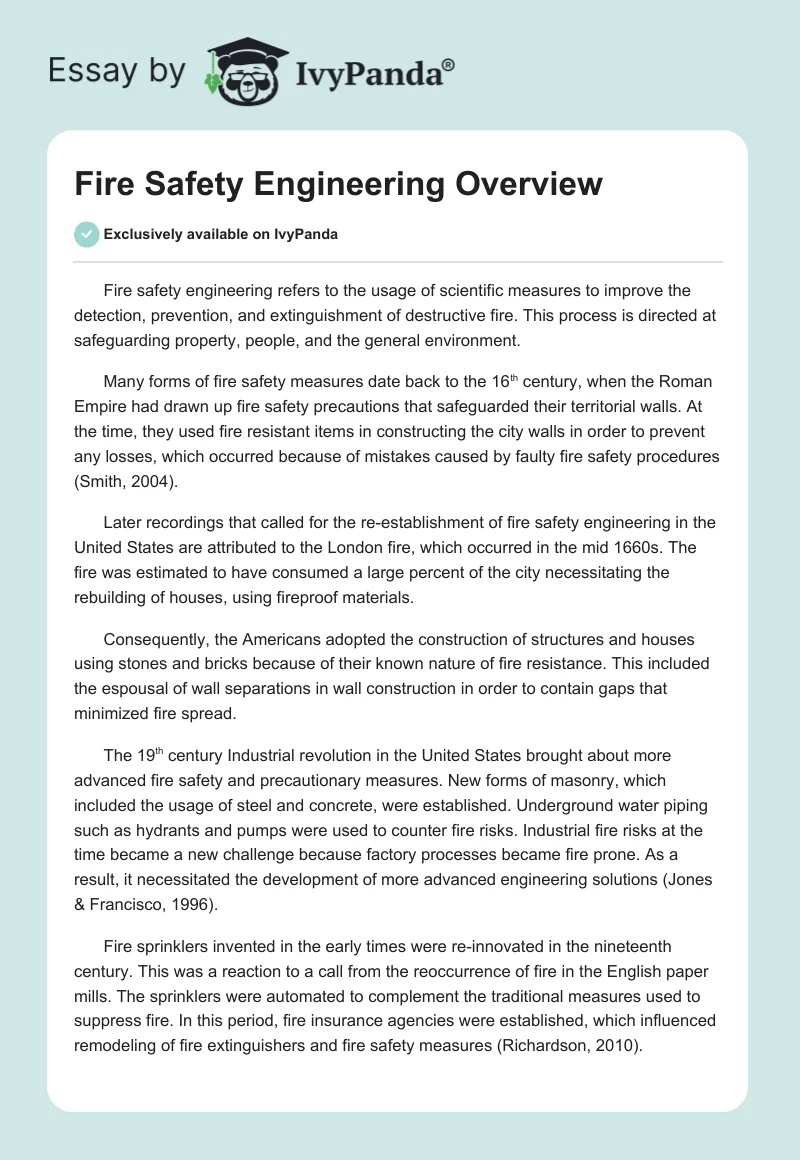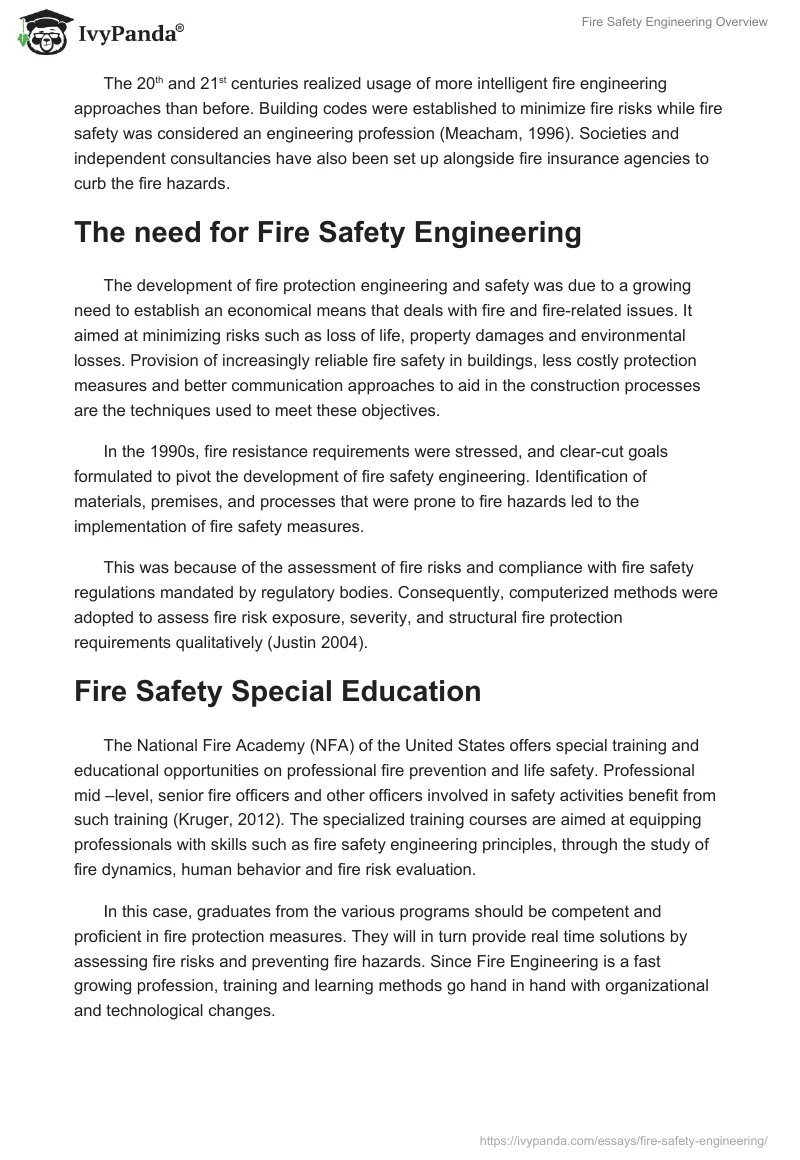Fire safety engineering refers to the usage of scientific measures to improve the detection, prevention, and extinguishment of destructive fire. This process is directed at safeguarding property, people, and the general environment.
Many forms of fire safety measures date back to the 16th century, when the Roman Empire had drawn up fire safety precautions that safeguarded their territorial walls. At the time, they used fire resistant items in constructing the city walls in order to prevent any losses, which occurred because of mistakes caused by faulty fire safety procedures (Smith, 2004).
Later recordings that called for the re-establishment of fire safety engineering in the United States are attributed to the London fire, which occurred in the mid 1660s. The fire was estimated to have consumed a large percent of the city necessitating the rebuilding of houses, using fireproof materials.
Consequently, the Americans adopted the construction of structures and houses using stones and bricks because of their known nature of fire resistance. This included the espousal of wall separations in wall construction in order to contain gaps that minimized fire spread.
The 19th century Industrial revolution in the United States brought about more advanced fire safety and precautionary measures. New forms of masonry, which included the usage of steel and concrete, were established. Underground water piping such as hydrants and pumps were used to counter fire risks. Industrial fire risks at the time became a new challenge because factory processes became fire prone. As a result, it necessitated the development of more advanced engineering solutions (Jones & Francisco, 1996).
Fire sprinklers invented in the early times were re-innovated in the nineteenth century. This was a reaction to a call from the reoccurrence of fire in the English paper mills. The sprinklers were automated to complement the traditional measures used to suppress fire. In this period, fire insurance agencies were established, which influenced remodeling of fire extinguishers and fire safety measures (Richardson, 2010).
The 20th and 21st centuries realized usage of more intelligent fire engineering approaches than before. Building codes were established to minimize fire risks while fire safety was considered an engineering profession (Meacham, 1996). Societies and independent consultancies have also been set up alongside fire insurance agencies to curb the fire hazards.
The need for Fire Safety Engineering
The development of fire protection engineering and safety was due to a growing need to establish an economical means that deals with fire and fire-related issues. It aimed at minimizing risks such as loss of life, property damages and environmental losses. Provision of increasingly reliable fire safety in buildings, less costly protection measures and better communication approaches to aid in the construction processes are the techniques used to meet these objectives.
In the 1990s, fire resistance requirements were stressed, and clear-cut goals formulated to pivot the development of fire safety engineering. Identification of materials, premises, and processes that were prone to fire hazards led to the implementation of fire safety measures.
This was because of the assessment of fire risks and compliance with fire safety regulations mandated by regulatory bodies. Consequently, computerized methods were adopted to assess fire risk exposure, severity, and structural fire protection requirements qualitatively (Justin 2004).
Fire Safety Special Education
The National Fire Academy (NFA) of the United States offers special training and educational opportunities on professional fire prevention and life safety. Professional mid –level, senior fire officers and other officers involved in safety activities benefit from such training (Kruger, 2012). The specialized training courses are aimed at equipping professionals with skills such as fire safety engineering principles, through the study of fire dynamics, human behavior and fire risk evaluation.
In this case, graduates from the various programs should be competent and proficient in fire protection measures. They will in turn provide real time solutions by assessing fire risks and preventing fire hazards. Since Fire Engineering is a fast growing profession, training and learning methods go hand in hand with organizational and technological changes.
Certification of Fire Safety Engineers
The National Institute for Certification in Engineering Technologies (NICET) certifies one’s proficiency and competency in fire management. NICET acts through its mission by providing certification, defining and supporting engineering career paths related to fire technicians and experts. They also help them obtain recognition and rejuvenate developments throughout their profession. In this regard, they develop schemes that help them be conversant with technological and organizational changes.
Professional Organization in the united States
The United States Fire Administration (USFA) and the National Fire Academy (NFA) under the umbrella of The Department of Homeland Security oversees matters concerning Fire Safety Engineering. The institution makes sure that the registered engineers satisfy the minimum standards required by the Federal Emergency Management Agency (FEMA) and Fire Service Training Standards and Regulations.
The overseeing authorities strategize on the reduction of the number of injuries, deaths and losses from fire hazards. Thus, it provides leadership, coordination, and support for the nation’s fire prevention control, fire training and education and emergency medical services (Kruger, 2012).
Salaries and Demand for Fire Safety Engineers
The salaries of fire engineers vary according to the kind of services they provide. The national average salary for degree holders in the field varies between $50,000 and $100,000 per year. When their job profiles include extra services like consultancy regarding fire protection, an additional fee is charged, and as a result, increases the total salary package. Other charges are based on commissions or bonuses.
The demand for fire protection engineers has been on the rise. This is because fire engineers are pre-requisite employees when designing buildings, products and manufacturing processes.
They have to work with architects, home and industry owners, builders and potential buyers of property in designing and inspecting homes and buildings (Justin, 2004). Unlike in previous periods, where critical fire protection decisions reserved for fire engineers were made by non-engineers, currently only competent engineers are allowed to make such decisions.
Major duties of Fire Engineering
Fire safety engineering’s main objective is to provide the protection of health and life safety. This is aimed at attaching value to human health and the necessity of life safety. The objective is implemented by securing health and life safety of occupants in case of fire occurrence.
Evacuation procedures are established within building structures while life safety equipments are made available inside and outside the buildings. The safety of the firefighters in case of an outbreak is taken care of by providing proper fire tackling techniques, preventing collapse of buildings, and assessing fire resistance levels to enable safe fire fighting (Nolan, 2006).
Protection of property is also an essential task in fire protection. The level at which property can bear the consequences of potential fire risk losses can be assessed to minimize risk exposure. The buildings and their contents are safeguarded from damage caused by fire. Protection of property is a critical activity, which involves prevention of vicinity damage, and minimization of business interruptions and protection of public image.
Consequences caused by fire damage to the environment may be devastating. This has apparently set up an increase in engineers’ tasks to counteract imminent fire outbreaks by preventing ignitions and suppressing fires. Smoke and other effluents are hazardous to the atmosphere, and for that reason, they should call for reduction of pollution in the environment.
Architectural, historical, and cultural heritage has to be protected against fire. Though the damage caused by fire cannot be monetized, there is a societal duty to protect them. Infrastructural systems that can be damaged by fire hazards have to be protected from fire. This will help minimize data losses, disruption of communication and the operational losses to public services, such as transport.
Successes of Fire Engineering
The science of fire protection engineering has gone considerable lengths in the reduction and minimization of damage caused by fire. Over the years, the world has seen the invention of medieval forms of combating fire risk until the current post-modern techniques available. Although there are many forms of engineering that can reduce exposure to fire risks drastically yet to be implemented, there has been a considerable margin of success in the implementation of fire protection and safety measures.
The process of fire safety has been transformed from the noble cause, which was to reduce the burden of fire hazards, to the prevention and suppression of fires. The Japanese viewpoint of fire safety engineering in itself is a milestone. This has helped to avoid the repetition of mistakes on fire safety procedures through the review of building materials, creation of fire-tight compartments, increasing fire resistance and control of smoke and other effluents.
The initiative of fire protection engineering has seen the establishment of fire safety laws, health and safety executives, regulators’ compliance codes, and enforcement concordats. This ensures the adherence to fire safety precautions and the prosecution of violators of the codes.
The business community has also collaborated with the public in relationships aimed at aligning measures that implement fire protection strategies. False fire alarms are cautioned against, therefore, ensuring the best use of resources through the creation of awareness to exercise caution before triggering them. This is a recount of the successes of fire protection and safety engineering.
The detection, control, and processes of extinguishing of fire have been enhanced by the improved understanding of behavior of materials, structures, and human beings towards fire. This has enhanced the safeguarding of human life, property, and the environment from fire. Fire departments have integrated fire safety systems to undertake the process of fire protection engineering fully (John, 2007).
Conclusion
In my opinion, issues addressed by fire protection and safety engineering depict that it is a vital program in a society. Consequently, research and education on fire and fire-related issues should be adopted worldwide to improve on the quality of life. Fire laws and building codes must be enforced to minimize the damages caused by fire.
On the other hand, the compliance with fire safety legislation should not be viewed as a hindrance to the minimization of construction costs, but it should be taken as a matter that safeguards life, property and the environment against potential losses.
The collective responsibility of ensuring fire safety and health protection should be encouraged by championing all partnerships aimed at safeguarding life, property and the environment. Professional bodies and learning institutions have to energize graduates, and help them adapt to technological changes to keep them up to date.
References
Cote, A. E. (2004). Fundamentals of fire protection. Quincy, Mass.: National Fire Protection Association.
John, J. (2007). A collection of papers presented by the Fire Safety Engineering Group at INTERFLAM’2007, 11th International Conference on Fire Science and Engineering, University of London. London: CMS Press, Centre for Numerical Modeling and Process Analysis, University of Greenwich.
Jones, W. W., & Francisco, C. J. (1996). The evolution of HAZARD, the fire hazard assessment methodology. Gaithersburg, MD: National Institute of Standards and Technology.
Justin, P. (2004). Strategies for shaping fire safety engineering research: a report on the Fire Safety Engineering Research Network (FERN) workshop on 2004.. Newtownabbey: Institute of Fire Safety Engineering Research & Technology, University of Ulster.
Kruger, L. G. (2012). United States Fire Administration: An Overview. Congressional Research Service, 2(1). Web.
Meacham, B. J. (1996). The evolution of performance-based codes & fire safety design methods. Boston, MA: Society of Fire Protection Engineers.
Nolan, D. P. (2006). Encyclopedia of fire protection (2nd ed.). Clifton Park, NY: Thomson Delmar Learning.
Richardson, B. (2010). Fire safety engineering (3rd ed.). London: Chartered Inst. of Building Services Engineers.
Richardson, J. K. (2003). History of fire protection engineering. Quincy, Mass.: National Fire Protection Association.
Smith, D. N. (2004). Fire safety engineering. New York, NY: BHRA, the Fluid Engineering Centre.


